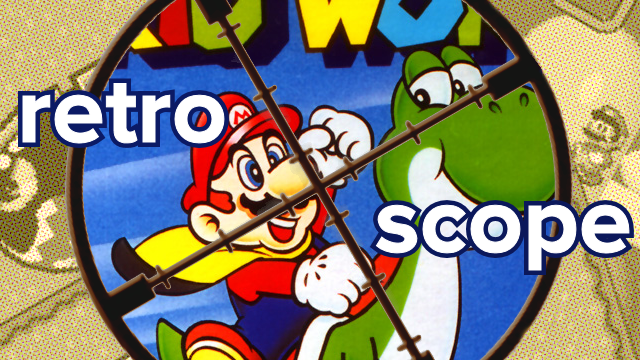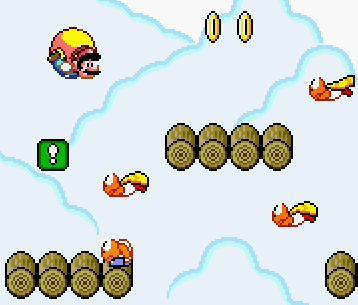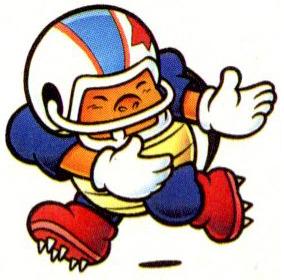
My sister learned to walk as I played Super Mario World. I can vividly remember being in my aunt’s room, maneuvering Mario through the deadly waters of Vanilla Fortress, when she took her first steps. Fishbones darted around as I heard my family cheering Angela, while I carried on with the much more important task of smacking Reznor into the pool of lava under its spinning platforms. Such is the magic of Super Mario World that even important things paled in the wake of its shadow!
Following in the footsteps of Super Mario Bros. 3 was no small order, but Super Mario World made it look easy. Even now, the game is such a joy to play that I have a really hard time proclaiming one to be better than the other. As a freshman effort on SNES, it’s amazing what Nintendo accomplished with this game. World is challenging, colorful, and stuffed with secrets. The secrets, in particular, are a very special part of this game, as few titles can hold a candle to the scope and variety of those found in World. Just think about Star Road; not only do you have to find it, but once you do, each level has its own hidden exit, and then they in turn lead to the even more secret Special Zone! As a kid, this intricate layering and density of the levels left me awestruck. Now, I’m still impressed at the sheer volume of content to discover, as most modern games aren’t anywhere near as generous.

Speaking of the Special Zone, I’ve always loved how completing it totally transforms the overworld and graphics of every single stage. Koopas become Mask Koopas, Bullet Bills are replaced with Pidgit Bills, and Piranha Plants become Jumping Pumpkin Plants. It didn’t do anything to alter gameplay, but it was a real treat for going through all the trouble of completing the ridiculously challenging Special Zone. The names of those stages are hilariously ’90s, by the way. Gnarly, Tubular, and Mondo are just a few examples of how Nintendo tried to tap into the over-the-top spirit of the decade. The fourth wall break when you beat the Special Zone was also a nice touch, as it served as a knowing little wink to players who’d been with the Mario series from the beginning. It’s just a thank you, but seeing the message reveal itself as a monument of coins was a sight to behold.
Musically, World is easily a top 5 contender for the best soundtracks Koji Kondo ever produced. The game’s primary theme is reworked in a number of clever ways, and who could ever forget the haunting Ghost House music? A personal favorite of mine is the final boss music when Mario encounters Bowser at the end. The song provides a perfect sense of drama and gets my blood pumping every time. After years of making music on NES’s more restrictive sound chip, the freedom SNES offered is clear just by listening to Kondo’s score in World. It’s truly every bit as classic as any of the other Mario games before it. Just so you know, you’re not alone if the song that plays during the credits gets you all misty.

There’s no way to talk about World without mentioning Mario’s cape. The iconic yellow swatch of fabric pinned to his back perfectly captured the grandeur of the game. The sense of empowerment from flying with the cape is almost electric. Not only that, but the tricks you can pull off with it are insane. Who needs to flip all the switches to get to the hidden exit of Star World 5 when a perfectly aimed cape shot will suffice? If you really want to impress your friends, though, there’s nothing better than pulling off the Cheese Bridge trick to get to Soda Lake. The easy way is to float Yoshi under the exit and jump off of him behind the gate to get to the secret exit. If you want to go hardcore, though, you fly Mario between the rotating and shifting buzz saws to get behind the exit gate, instead. That’s how you go old school Grand Master Galaxy, my friends.
As a Mario aficionado, I also can’t help but notice in hindsight how floaty Mario’s jump is in World. He feels lighter in this game than any of the other platformers, whether 3D or 2D. It’s not bad, certainly, but it’s different. The absence of standard breakable bricks is another interesting omission, and yet another element that cemented World as one of the most experimental titles in the Mario series. Yoshi, the switch palaces, spin jumping, gate climbing, and more are all part of the incredible wealth of innovations to the Mario formula that World introduced. Replaying the game today is as fresh as it was when I was a boy, a teenager, and a young adult. Some games are truly timeless, and Super Mario World is one of them.




 ShareThis
ShareThis






